Acoustics get a starring role in the design of a new performing arts center
![]() Continuing Education
Continuing Education
Use the following learning objectives to focus your study while reading this month’s Continuing Education article.
Learning Objectives - After reading this article, you will be able to:
- Recognize and define diverse acoustical terminology.
- Explain how acoustical concerns affected the structural and mechanical design of EMPAC.
- Describe various treatments used to improve sound quality.
Acoustic surface treatments and baffles may work to improve the quality of sound transmission in ordinary spaces, but to create world-class performance venues where the need for pristine acoustics is critical, every aspect of the design-from formal and spatial considerations to structural and mechanical needs-are closely examined by a team of architects, engineers, and acousticians. The Curtis R. Priem Experimental Media and Performing Arts Center (EMPAC) at Rensselaer Polytechnic Institute (RPI) contains four distinct performance and recording spaces, each requiring first-rate acoustics-a challenge for any single building to accommodate, but one made even more daunting given this building's dramatic siting in a hillside.
Grimshaw Architects was charged with designing this complicated structure, their first performing arts building, after winning an invited competition in 2001. Partnering with Buro Happold Consulting Engineers and architect-of-record Davis Brody Bond Aedas, Grimshaw's New York office had to roll with the punches as EMPAC's program evolved into a 220,000-square-foot building that includes a 1,200-seat concert hall, a 400-seat theater with a full fly tower, two black-box studios for experimental media, artist-in-residence studios, a dance studio, audiovisual production suites, and support facilities. According to RPI president Shirley Ann Jackson, "EMPAC is an extraordinary venue where science, research, and performance meet."
Grimshaw arranged the concert hall and atrium axially with the main entrance in a linear sequence on the north side of the building, while the studios and theater form an adjacent sequence on the south. The main programmatic space is the most visible. Encased in a wooden hull, the floating ovoid of the concert hall penetrates the building's west facade overlooking the small town of Troy, New York. Hidden behind the cedar planks-arranged in a decorative chevron pattern-is a sophisticated steel framework which, among other things, provides support for access bridges to the concert hall. The bridges rest on acoustic isolation barriers.
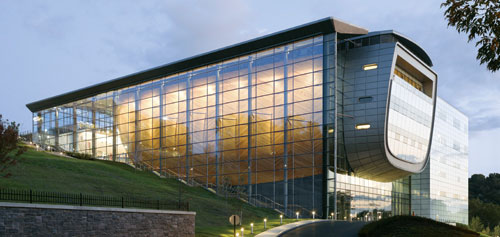 |
Penetrating the building?s west facade (top), the wood hull of the concert hall is the most prominent feature of EMPAC?s exterior. Several bridges provide access to its interior (below). Photos © Chuck Choi |
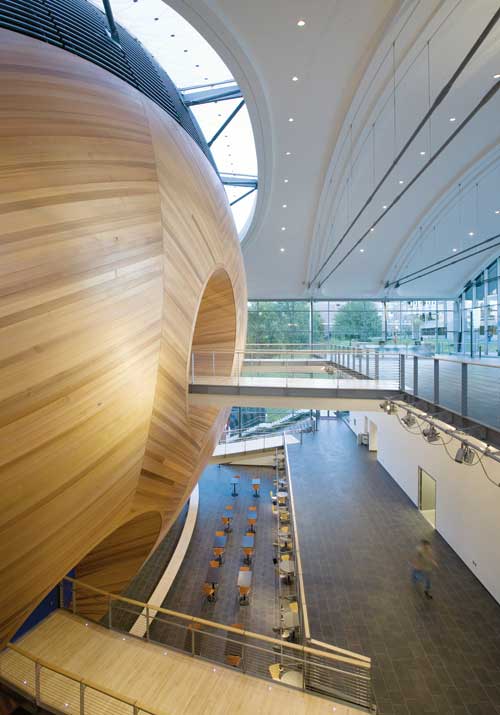 |
Â
Inside, the concert hall takes on a shoebox shape, the long walls of its concrete inner shell slightly curved to avoid cross-room flutter (successive, repetitive sound reflections that bounce off parallel walls). While much thinner dimensions would have sufficed for structural purposes, the slabs of the concrete shell average 14 inches in thickness to provide superior isolation from exterior noise. Affixed to the inside surfaces of the upper walls is an array of gently convex- and concave-shaped cast-concrete panels, bringing the overall thickness of the walls to 22 inches in some locations. These panels, along with ravioli-shaped, glass-fiber-reinforced gypsum panels in the gallery level (where the curvature is most pronounced), and wiggle-shaped maple strips on the lower walls, all help to diffuse sound throughout the concert hall, aided by the overall convex shape of the auditorium. The interior shaping of the surfaces, and inclusion of sound-reflecting panels, combine to control tone and liveness.
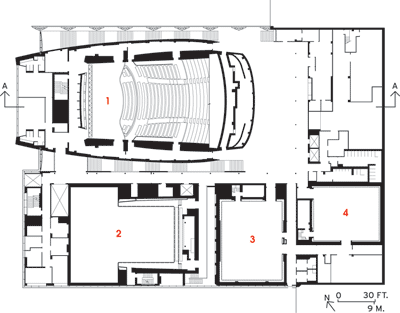 |
1. Concert hall 2. Theater 3.Studio 1 4. Studio 2 |
Â
The surface of the concrete panels, which contain pulverized limestone, has a very fine porosity, carefully chosen and analyzed to provide some high-frequency absorption in addition to the sound diffusion created by its geometric shaping. "Musicians love concert halls where they can hear themselves really well, where it doesn't get overly loud, and where there are no confusing reflections," explains Larry Kirkegaard, Hon. AIA, president of Chicago-based Kirkegaard Associates, the acousticians for EMPAC. "Sound should come back to the stage as a warm hug, not as a Heimlich maneuver." Selected for its fire-retardant attributes, the tightly woven Nomex fabric of the ceiling panels allows performers to hear themselves and each other through a balanced reflection of middle and high frequencies. To achieve the desired warmth and presence of acoustic reflections, the custom-engineered ceiling also lets lower frequencies partially flow through it. Warmth has a clearly observable effect on orchestral timbre-the quality of sound that distinguishes one instrument from another.
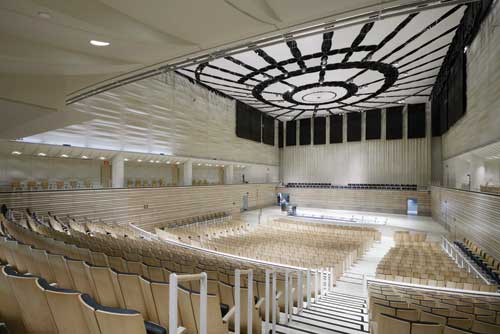 |
Variously shaped cast concrete, gypsum, and wood panels; a fabric ceiling; and custom designed seats aid the acoustics in the concert hall (top). The shoebox-shaped volume is separated from the mechanical room below by a plenum (bottom). Photo © Chuck Choi; image courtesy Kirkegaard Associates |
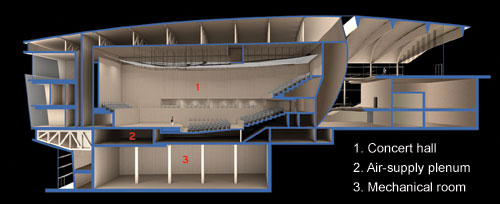 |
Â
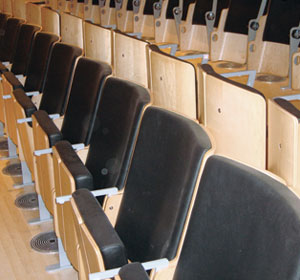 |
Conditioned air rises from the plenum through grilles that are located at each seat, an efficient and quieter option than pushing air through an overhead system. Photo courtesy Kirkegaard Associates |
With all the measures taken to ensure optimum acoustics within the concert hall, the last thing anyone wanted to do was introduce noisy HVAC equipment into the space. Therefore, the auditorium is cooled through underfloor air distribution. Fresh air slowly and silently rises through grilles distributed throughout the floor from a large, pressurized plenum below the stage and audience. Each of the fixed audience seats-custom designed by Grimshaw with Billings Jackson to optimize ergonomics and acoustics-features a diffuser below it, barring instances where structural elements under the floor get in the way.
This type of displacement ventilation is becoming the standard for state-of-the-art performance venues, not only because of the lower noise levels, but because of issues of audience comfort (no drafts) and sustainability (inherent energy savings). "The whole problem with delivering air from the ceiling level in large, high spaces like these is that you have to deliver it at much higher velocities to get past the hot zone of the lighting and down into the occupied area," explains Denzil Gallagher, head of Buro Happold's m/e/p project team.
Gallagher was also responsible for keeping the noise down in the mechanical room, which occupies a three-story space directly below the concert hall. "It's a risky location because of the possibility of noise transfer," he says. "But the plenum acts as an acoustic barrier." Moreover, a number of efforts were made to keep the mechanical room as quiet as possible. One reason for the room's huge volume is the sheer size of the equipment housed there. Ducts and ventilation shafts are three to four times bigger than in conventional buildings so that air moves at slower velocities within them.
The engineers were able to save some space, however, with a relatively new technology that they specified in a project for the first time with EMPAC. Rather than using an air-handling unit with a large, centrifugal fan, they opted for a Fanwall system that uses a series of small, direct-drive fans. But more than the space-saving benefits, the system achieves 20 to 30 percent noise reduction, especially at low frequencies, which are typically very difficult to eliminate. (High-frequency noises are treated more simply with sound traps-duct liner, for instance.) Flexible pipe connectors in the mechanical room-and similar measures at various building joints-prevent vibration from entering into other spaces, walls, or floor systems. The sum of these efforts prevents cross-talk, breakout-noise, and plant-noise transmission.
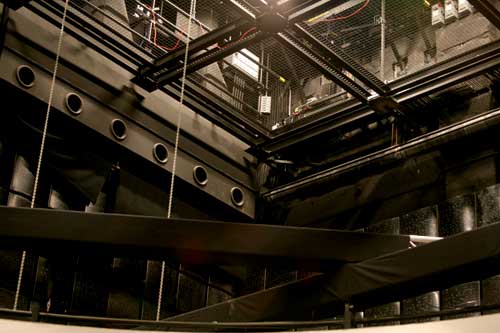 |
|
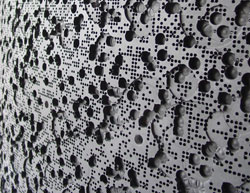 |
The wire grid ceiling over the studios provides a walkable surface and structure from which to hang banners, diffusers, and 360-degree screens for immersive performances (top). Computer-milled acoustical panels in the studios have random, pocked surfaces (left) and are lined up along the studio walls (below left). Live sound testing is performed on a mockup of the panels (below). Photo courtesy Kirkegaard Associates |
 |
|
Â
The mechanical room, like the concert hall, is constructed as a "box-in-box." A steel frame covered in several layers of gypsum board surrounds the room's enclosed space, yet does not touch any of its columns, or the slab above (closest to the concert hall). In this way, all the equipment contained within it is further isolated from the concert hall.
EMPAC is in effect a series of structurally isolated buildings, due in large part to the need for acoustic isolation during simultaneous performances. Nowhere is this more evident than in the two black-box studios. The larger of the two, called Studio 1, is fully base-isolated, an extreme measure used mainly in earthquake-prone areas or for sensitive laboratories. "Typically, this type of space would employ just a jack-up slab for the floor," admits Craig Schwitter, who led Buro Happold's structural design. "Here, all of the slabs, including the 12-inch-thick floor slab and the 60-foot-high walls, were poured and then lifted up on springs. Studio 1 is truly a floating building within a building."
Studio 2, on the other hand, sits on completely separate foundations from the rest of the building. "There was concern about noise literally traveling down into the ground and cross-talking between concrete beams," says Schwitter. "Above Studio 2 are additional spaces that span over the studio, but don't rest on it." These structural gymnastics were further complicated by New York State's adoption of the International Building Code in 2002, which dictated that the building address seismic issues. Because of the sloping hillside into which EMPAC is embedded, it was placed in a higher seismic category than is typical for the region. As each element of the building is a unique structure, individual venues had differing drift characteristics. All movements were coordinated with up to 4-inch joints in many areas.
 |
1. Theater 2. Studio 1 3. Studio 2 |
Â
 |
Studio 1 is fully base-isolated. A series of springs is cast into the poured-concrete floor slab (above). The foundations for Studio 2 are physically separate from the rest of the building. Flexible pipe connectors in the mechanical room prevent vibration from entering into other spaces, walls, or floor systems (bottom). Photos courtesy Buro Happold (top and bottom left) ; courtesy Kirkegaard Associates (bottom right) |
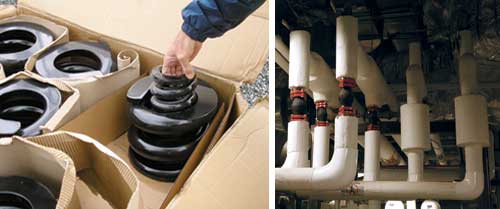 |
Â
Beyond the studios' unique structural aspects were their highly specialized interior requirements. Studio 1 is optimized for scientific visualization, multiscreen and immersive performances, and dance; Studio 2 for music recitals and recordings. Acoustic requirements were stringent for both. Each studio's walls are lined with a series of specially developed gypsum acoustic panels, arranged as a grid, which reflect and scatter sound. The panels in Studio 1 feature a perforated metal surface backed with absorptive material. Inspired by the bark of a tree, the panels are computer-milled to contain random, pocked surfaces. "Sound waves interfere with each other when they experience repetitive surfaces," says Kirkegaard.
Each time a traveling sound wave bounces back from a room surface, its strength is weakened by the sound absorption of that surface. The time it takes for a loud sound to decay to inaudibility after being cut off is called the reverberation time (RT). According to Kirkegaard, the RT in Studio 1 prior to installing the acoustic panels (and the resonant absorbers behind them) was between 7 and 10 seconds-quite long. After installation of these critical elements, the RT was reduced to less than a second. (By contrast, the RT in the concert hall is closer to 2 seconds.)
Both studios feature a wire grid ceiling that provides a walkable surface upon which technicians can work to adjust the room to fit the needs of individual performances. Banners, diffusers, and screens can be hung from this surface for use in video projections, three-dimensional presentations, and immersive environments.
"The studios were probably the most complicated spaces to design," Gallagher concedes. "The noise criteria was as strict for them as for the concert hall. Nowhere else in the world do you have a building with not one or two, but four world-class acoustic spaces." The criteria Gallagher refers to are Room Criteria (RC), which measures the background noise in a space over a certain frequency range. While the average RC range for ordinary spaces like restaurants and even libraries is between 30 and 40, the requirements for all the spaces at EMPAC were RC15-in other words, quiet enough to hear a pin drop.
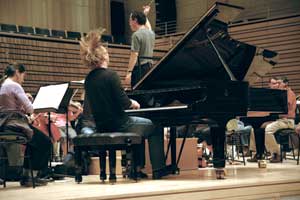 |
After Studios 1 and 2, the theater makes up the last major performance space in EMPAC's southern block-which consists of a total of six independent structures linked by a spine. Smaller and less formal than the concert hall, the physical space of the theater is meant to recede as the stage lights come up. The theater can be used with or without its orchestra pit. Movable seating at the parterre level along the sides allows artists to configure the theater as proscenium space, or to extend the playing area along the sides of the audience. The major acoustical intervention involved making the winch equipment around the stage and within the 70-foot-tall fly tower as quiet as possible-achieved primarily through one of the most advanced computer-controlled rigging systems in the world. Like the concert hall, the theater uses displacement ventilation.
Barely noticeable to the average audience member, ordinary filament lights produce a small amount of noise when dimming. This concern-among countless seemingly minor issues-was addressed in the theater and elsewhere by using a sound wave dimmer.
Operational since October, all reviews seem to indicate that the stringent acoustic levels demanded by the designers and client have been achieved. But while an extraordinary effort was put forth to make EMPAC as technically perfect as possible, its mission is something else entirely. "This building is not about the technology," says EMPAC founding director Johannes Goebel. "It is all about the experience of people seeing, hearing, and moving inside it."
